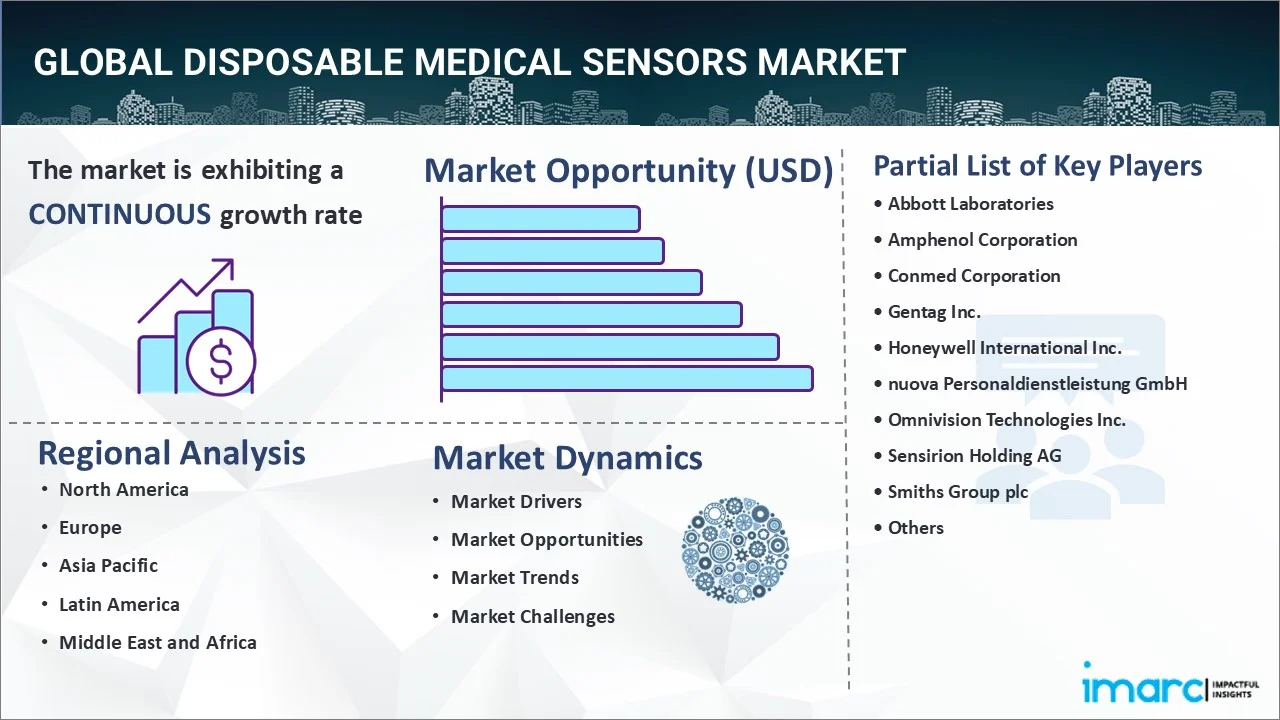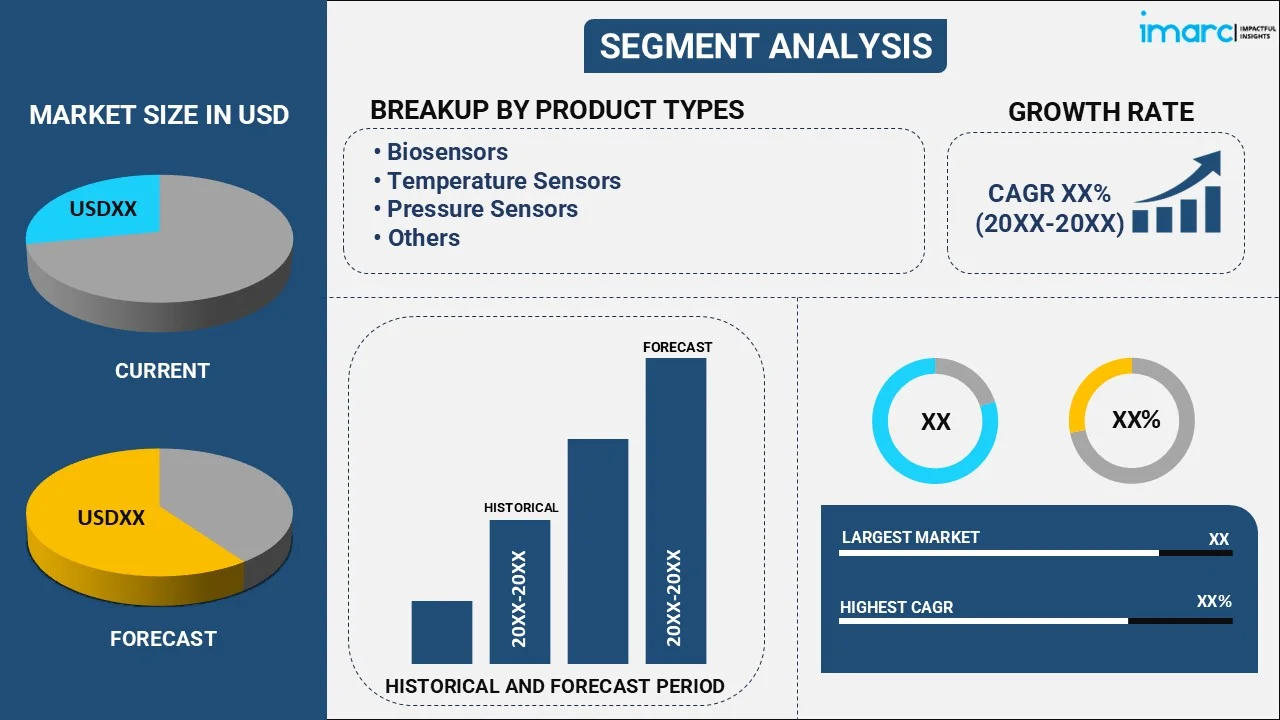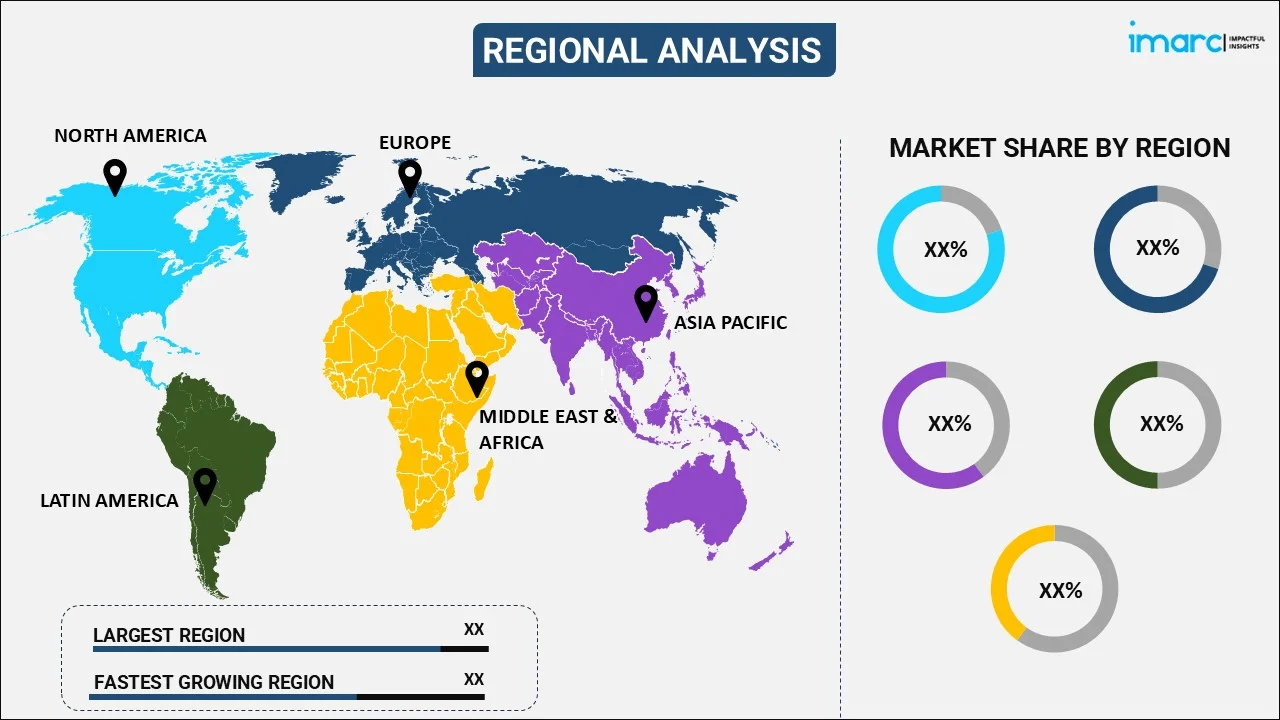
Disposable Medical Sensors Market Report by Product Type (Biosensors, Temperature Sensors, Pressure Sensors, Image sensors, Accelerometers and Patient Position Sensors, and Others), Placement Type (Wearable Sensors, Implantable Sensors, Ingestible Sensors, Invasive Sensors, Strip Sensors), Application (Patient Monitoring, Diagnostics, Therapeutics), End User (Hospitals, Home Care, Clinics, Diagnostic Laboratories), and Region 2025-2033
Global Disposable Medical Sensors Market:
The global disposable medical sensors market size reached USD 9.4 Billion in 2024. Looking forward, IMARC Group expects the market to reach USD 17.5 Billion by 2033, exhibiting a growth rate (CAGR) of 7.1% during 2025-2033. The increasing adoption of point-of-care (PoC) and at-home diagnostic devices to monitor post-operative rehabilitation and elderly patients, along with the continuous improvements in the healthcare infrastructures, are bolstering the market growth.
|
Report Attribute
|
Key Statistics |
|---|---|
|
Base Year
|
2024 |
|
Forecast Years
|
2025-2033 |
|
Historical Years
|
2019-2024
|
| Market Size in 2024 | USD 9.4 Billion |
| Market Forecast in 2033 | USD 17.5 Billion |
| Market Growth Rate 2025-2033 | 7.1% |
Global Disposable Medical Sensors Market Analysis:
- Major Market Drivers: The rising applications of disposable medical sensors for several radiological, cardiological, and neurological procedures, as they transmit and detect information regarding vital signs, including oxygen levels, pulse rate, heart rate, and temperature, in the form of electrical signals, are one of the key factors driving the market growth. Besides this, the increasing instances of hospital-acquired infections (HAIs) are also bolstering the market growth.
- Key Market Trends: The disposable medical sensors market's recent developments include the growing integration of micro-technologies, such as microfluidic chips, lab-on-a-chip systems, medical micro-electro-mechanical systems (MEMS), etc., for monitoring of patients with enhanced precision. Moreover, the inflating expenditure capacities of individuals in the healthcare sectors are further propelling the disposable medical sensors market revenue.
- Geographical Trends: According to the disposable medical sensors market statistics, North America currently dominates the global market. The increasing usage of sensor-based devices is primarily stimulating the regional market. Additionally, the rising investments by venture capital firms to introduce advanced disposable medical device sensors are also positively influencing the market growth in North America.
- Competitive Landscape: Some of the leading players in the global disposable medical sensors market include Abbott Laboratories, Amphenol Corporation, Conmed Corporation, Gentag Inc., Honeywell International Inc., nuova Personaldienstleistung GmbH, Omnivision Technologies Inc., Sensirion Holding AG, Smiths Group plc, Starboard Medical Inc., TE Connectivity Ltd., and Vital Connect Inc., among many others.
- Challenges and Opportunities: The increasing concerns towards the limited functionality of disposable medical sensors as compared to reusable sensors are one of the primary challenges hindering the disposable medical sensors market opportunities. Furthermore, complexities in supply chains may affect the costs and accessibility of these sensors. However, the rising number of approval processes by regulatory bodies and the elevating awareness among individuals towards the early detection of diseases is projected to create a positive impact on the disposable medical sensors market outlook in the coming years.

Global Disposable Medical Sensors Market Trends:
The Increasing Demand for In-Home Patient Monitoring
The increasing need for remote patient monitoring, as it allows hospitals and physicians to monitor patients outside of the conventional clinic setting, is stimulating the disposable medical sensors market share. The Centers for Medicare and Medicaid Services (CMS) reported that every year, patient monitors aid individuals in avoiding being readmitted to the hospital. Moreover, users who adopted remote monitoring reported a 76% reduction in readmission rates, an average of 89% patient satisfaction, and a total medical cost savings of nearly US$ 370 Million. Consequently, various global and small-scale companies are providing disposable medical sensors, which is acting as another significant growth-inducing factor. Some of the prominent players offering these sensors include Smiths Medical and Mediaid. Besides this, manufacturers are also introducing medical devices that help patients to carry even in public spaces. For example, in July 2020, BioIntelliSense and Philips entered into a strategic partnership to enhance remote patient monitoring for individuals at risk. The collaboration made it easier for doctors to keep an eye on patients who are being treated in hospitals at home.
Continuous Advancements in Medical Sensors
The key players are focusing on introducing novel technologies, including the development of micro-electro-mechanical systems (MEMS) sensor technology, cancer tracking sensors, and fiber optic technology, which, in turn, is catalyzing the disposable medical sensors market demand. In addition to this, these innovations enhance business by simplifying the use of the device, increasing productivity, and making it convenient for patients to improve their health. For example, in the disposable medical sensors market in 2021, the first 8-megapixel (MP) resolution sensors for single-use and reusable endoscopes were launched by OMNIVISION Technologies, Inc., in the month of June. Similarly, in April 2022, Variohm EuroSensor introduced a NTC thermistor, which was specifically designed for medical equipment use and sensing ambient medical area temperatures and small temperature changes in the body. Apart from this, in February 2022, EnSilica developed the ENS62020, an ultra-low-power healthcare sensor interface to monitor vital signs in wearable medical and healthcare devices. These advancements will continue to stimulate the disposable medical sensors market price in the coming years.
Regulatory Approvals
The development of novel disposable medical sensors can be attributed to the rising number of regulatory approvals by government bodies. For example, in July 2020, ivWatch, LLC, a prominent player in biosensor technology, received Food and Drug Administration (FDA) clearance for its SmartTouchTM disposable sensor for the early detection of extravasation and peripheral IV infiltration events. This new FDA clearance expanded the ivWatch sensor portfolio to provide infusion centers, hospitals, and other healthcare facilities with complementary sensor solutions to enhance patient safety and minimize the risks associated with IV therapy.
Disposable Medical Sensors Industry Segmentation:
IMARC Group provides an analysis of the key trends in each segment of the market, along with forecasts at the global, regional, and country levels for 2025-2033. Our report has categorized the market based on product type, placement type, application, and end user.
Breakup by Product Type:

- Biosensors
- Temperature Sensors
- Pressure Sensors
- Image sensors
- Accelerometers and Patient Position Sensors
- Others
Biosensors currently exhibit a clear dominance in the market
The report has provided a detailed breakup and analysis of the market based on the product type. This includes biosensors, temperature sensors, pressure sensors, image sensors, accelerometers and patient position sensors, and others. According to the report, biosensors accounted for the largest market share.
A biosensor refers to a sensor that is utilized to detect the analyte. Some of the common types of biosensors available are potentiometric, conduct metric biosensors, electronic, blood glucose, thermometric, piezoelectric biosensors, etc. The growing need for performing faster diagnosis is expected to augment the market growth in this segment. For example, in May 2020, BioIntelliSense, Inc., a clinical intelligence and continuous health monitoring company, reported the advancement of its data-as-a-service (DaaS) platform and medical-grade biosensor product portfolio with the development of the BioButton device.
Breakup by Placement Type:
- Wearable Sensors
- Implantable Sensors
- Ingestible Sensors
- Invasive Sensors
- Strip Sensors
Currently, strip sensors hold the majority of the total market share
The report has provided a detailed breakup and analysis of the market based on the placement type. This includes wearable sensors, implantable sensors, ingestible sensors, invasive sensors, and strip sensors. According to the report, strip sensors accounted for the largest market share.
Strip sensors are generally adopted in disease testing, blood glucose monitoring, and magnetic nanoparticles. The strip sensors segment holds the largest market share on account of their widespread applications in diagnostics. Besides this, the emerging trend of self-diagnosis and the inflating popularity of home-based medical devices are bolstering the market growth in this segment.
Breakup by Application:
- Patient Monitoring
- Continuous Blood Pressure Monitoring
- Implantable Loop Recorder
- Cardiac Monitoring Electrode
- Pulse Oximeter
- Smart Pill
- Continuous Blood Glucose Monitoring (CGM)
- Others
- Diagnostics
- Capsule Endoscopes
- HIV Test Strip Sensors
- Pregnancy Test Strip Sensors
- Drug and Alcohol Test Strip Sensors
- Blood Glucose Test Strip Sensors
- Therapeutics
- Insulin Pump Sensors
- Cardiac Therapeutic Electrode Sensors
- Cardiac Catheter Sensors
Among these, diagnostics represent the largest market share
The report has provided a detailed breakup and analysis of the market based on the application. This includes patient monitoring (continuous blood pressure monitoring, implantable loop recorder, cardiac monitoring electrode, pulse oximeter, smart pill, continuous blood glucose monitoring (CGM), and others), diagnostics (capsule endoscopes, HIV test strip sensors, pregnancy test strip sensors, drug and alcohol test strip sensors, and blood glucose test strip sensors), and therapeutics (insulin pump sensors, cardiac therapeutic electrode sensors, and cardiac catheter sensors). According to the report, diagnostics accounted for the largest market share.
The escalating demand for disposable medical sensors in a wide array of diagnostic devices, including spirometry, surgical tools, endoscopy, and medical imaging devices, is propelling the market growth in this segmentation. Apart from this, disposable medical sensors market overview indicates that the elevating occurrence of chronic diseases is inflating the need for diagnostics equipment. For example, in October 2020, Alifax S.r.l. and STMicroelectronics developed a quick and affordable portable solution to amplify genetic material (DNA1 and RNA) in patient samples for point-of-care molecular diagnostic detection by utilizing highly reliable Polymerase Chain Reactions (PCR) in real-time.
Breakup by End User:
- Hospitals
- Home Care
- Clinics
- Diagnostic Laboratories
Currently, home care accounts for the majority of the total market share
The report has provided a detailed breakup and analysis of the market based on the end user. This includes hospitals, home care, clinics, and diagnostic laboratories. According to the report, home care accounted for the largest market share.
The rising inclination towards remote patient monitoring is driving the overall market growth in this segmentation. Moreover, home care helps in minimizing the instances of hospital-acquired infections (HAIs) by adopting single-patient disposable medical sensors, thereby driving the market growth in this segmentation.
Breakup by Region:

- North America
- United States
- Canada
- Asia-Pacific
- China
- Japan
- India
- South Korea
- Australia
- Indonesia
- Others
- Europe
- Germany
- France
- United Kingdom
- Italy
- Spain
- Russia
- Others
- Latin America
- Brazil
- Mexico
- Others
- Middle East and Africa
North America leads the market, accounting for the largest disposable medical sensors market share.
The market research report has also provided a comprehensive analysis of all the major regional markets, which include North America (the United States and Canada); Asia Pacific (China, Japan, India, South Korea, Australia, Indonesia, and others); Europe (Germany, France, the United Kingdom, Italy, Spain, Russia, and others); Latin America (Brazil, Mexico, and others); and the Middle East and Africa. According to the report, North America accounted for the largest market share.
Favorable reimbursement policies are one of the key factors driving the market growth in North America. Besides this, the inflating adoption of mobile surgery centers and the escalating demand for effective emergency care are also acting as significant growth-inducing factors. Additionally, continuous investments by venture capital firms to introduce advanced disposable medical device sensors are further positively influencing the regional market. For example, in May 2022, Nemaura Medical, Inc., a medical technology company focused on supporting personalized digital coaching programs and commercializing a daily disposable wearable glucose sensor, reported that it had secured US$ 5 Million in non-dilutive funding via a clean debt facility with no convertible elements or warrants. Apart from this, the inflating expenditure capacities of individuals in the United States are expected to catalyze the disposable medical sensors market in the coming years.
Leading Key Players in the Disposable Medical Sensors Industry:
The market research report has provided a comprehensive analysis of the competitive landscape. Detailed profiles of all major companies have also been provided. Some of the key players in the market include:
- Abbott Laboratories
- Amphenol Corporation
- Conmed Corporation
- Gentag Inc.
- Honeywell International Inc.
- nuova Personaldienstleistung GmbH
- Omnivision Technologies Inc.
- Sensirion Holding AG
- Smiths Group plc
- Starboard Medical Inc.
- TE Connectivity Ltd.
- Vital Connect Inc.
(Please note that this is only a partial list of the key players, and the complete list is provided in the report.)
Disposable Medical Sensors Market Recent Developments:
- March 2024: A team at Tokyo University of Science (TUS) has developed the flexible paper-based AI health sensor composed of nanocellulose and zinc oxide (ZnO) nanoparticles that takes an optical input in real-time.
- January 2024: Medtronic plc, a global leader in healthcare technology, announced CE (Conformité Européenne) mark approval for the MiniMed 780G system with Simplera Sync, a disposable, all-in-one continuous glucose monitor (CGM) requiring no over tape or finger sticks.
- January 2024: Inspira Technologies OXY B.H.N Ltd., a pioneer in life support technology, announced its plan to launch a single-use disposable blood oxygenation kit, currently in development, for its INSPIRA ART medical device series.
Disposable Medical Sensors Market Report Scope:
| Report Features | Details |
|---|---|
| Base Year of the Analysis | 2024 |
| Historical Period | 2019-2024 |
| Forecast Period | 2025-2033 |
| Units | Billion USD |
| Segment Coverage | Product Type, Placement Type, Application, End User, Region |
| Region Covered | Asia Pacific, Europe, North America, Latin America, Middle East and Africa |
| Countries Covered | United States, Canada, Germany, France, United Kingdom, Italy, Spain, Russia, China, Japan, India, South Korea, Australia, Indonesia, Brazil, Mexico |
| Companies Covered | Abbott Laboratories, Amphenol Corporation, Conmed Corporation, Gentag Inc., Honeywell International Inc., nuova Personaldienstleistung GmbH, Omnivision Technologies Inc., Sensirion Holding AG, Smiths Group plc, Starboard Medical Inc., TE Connectivity Ltd. and Vital Connect Inc. |
| Customization Scope | 10% Free Customization |
| Post-Sale Analyst Support | 10-12 Weeks |
| Delivery Format | PDF and Excel through Email (We can also provide the editable version of the report in PPT/Word format on special request) |
Key Benefits for Stakeholders:
- IMARC’s report offers a comprehensive quantitative analysis of various market segments, historical and current market trends, market forecasts, and dynamics of the disposable medical sensors market from 2019-2033.
- The research study provides the latest information on the market drivers, challenges, and opportunities in the global disposable medical sensors market.
- The study maps the leading, as well as the fastest-growing, regional markets. It further enables stakeholders to identify the key country-level markets within each region.
- Porter's five forces analysis assist stakeholders in assessing the impact of new entrants, competitive rivalry, supplier power, buyer power, and the threat of substitution. It helps stakeholders to analyze the level of competition within the disposable medical sensors industry and its attractiveness.
- Competitive landscape allows stakeholders to understand their competitive environment and provides an insight into the current positions of key players in the market.
Key Questions Answered in This Report
The global disposable medical sensors market was valued at USD 9.4 Billion in 2024.
We expect the global disposable medical sensors market to exhibit a CAGR of 7.1% during 2025-2033.
The high prevalence of several chronic medical ailments, such as cancer, diabetes, asthma, and stroke, along with the widespread usage of disposable medical sensors for diagnosis, patient monitoring, and therapeutic applications, is primarily driving the global disposable medical sensors market.
The sudden outbreak of the COVID-19 pandemic has led to the growing adoption of disposable medical sensors, owing to consumers opting for remote healthcare facilities to reduce the risk of the coronavirus infection upon hospital visits or interaction with medical equipment.
Based on the product type, the global disposable medical sensors market has been divided into biosensors, temperature sensors, pressure sensors, image sensors, accelerometers and patient position sensors, and others. Among these, biosensors currently exhibit a clear dominance in the market.
Based on the placement type, the global disposable medical sensors market can be categorized into wearable sensors, implantable sensors, ingestible sensors, invasive sensors, and strip sensors. Currently, strip sensors hold the majority of the total market share.
Based on the application, the global disposable medical sensors market has been segmented into patient monitoring, diagnostics, and therapeutics. Among these, diagnostics represent the largest market share.
Based on the end user, the global disposable medical sensors market can be bifurcated into hospitals, home care, clinics, and diagnostic laboratories. Currently, home care accounts for the majority of the total market share.
On a regional level, the market has been classified into North America, Europe, Asia-Pacific, Middle East and Africa, and Latin America, where North America currently dominates the global market.
Some of the major players in the global disposable medical sensors market include Abbott Laboratories, Amphenol Corporation, Conmed Corporation, Gentag Inc., Honeywell International Inc., nuova Personaldienstleistung GmbH, Omnivision Technologies Inc., Sensirion Holding AG, Smiths Group plc, Starboard Medical Inc., TE Connectivity Ltd., and Vital Connect Inc.
Need more help?
- Speak to our experienced analysts for insights on the current market scenarios.
- Include additional segments and countries to customize the report as per your requirement.
- Gain an unparalleled competitive advantage in your domain by understanding how to utilize the report and positively impacting your operations and revenue.
- For further assistance, please connect with our analysts.
 Inquire Before Buying
Inquire Before Buying
 Speak to an Analyst
Speak to an Analyst
 Request Brochure
Request Brochure
 Request Customization
Request Customization




.webp)




.webp)












